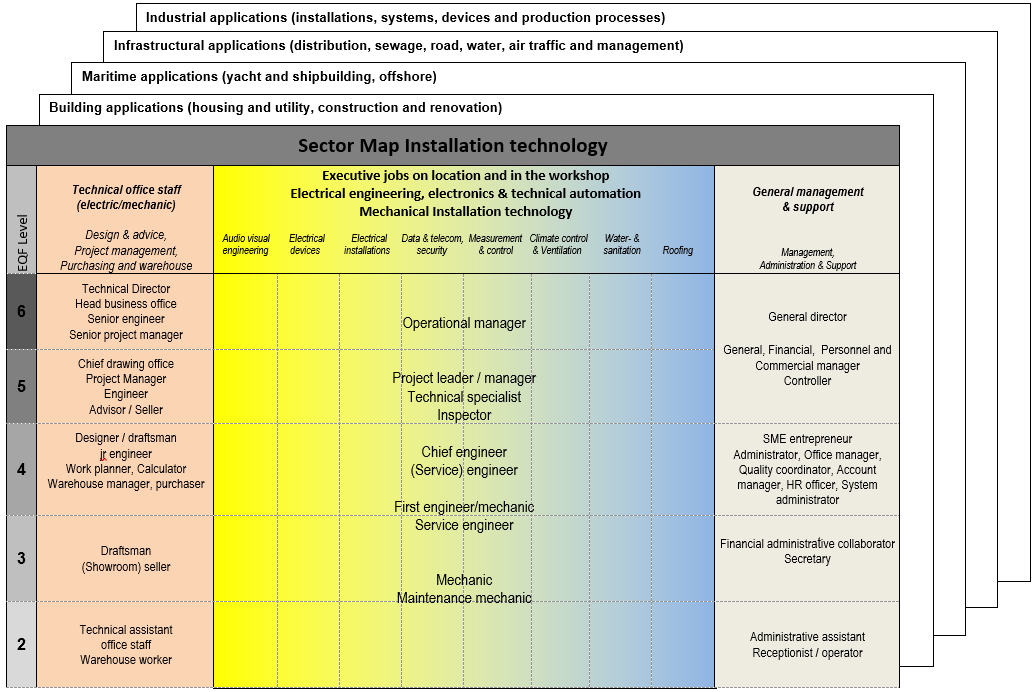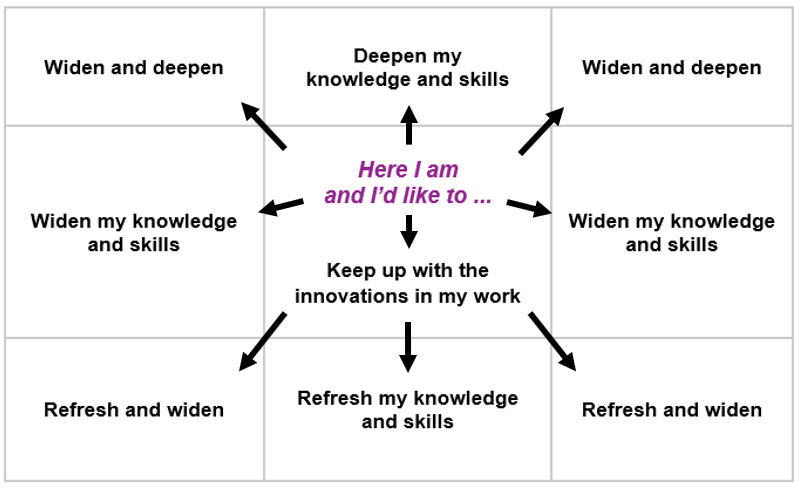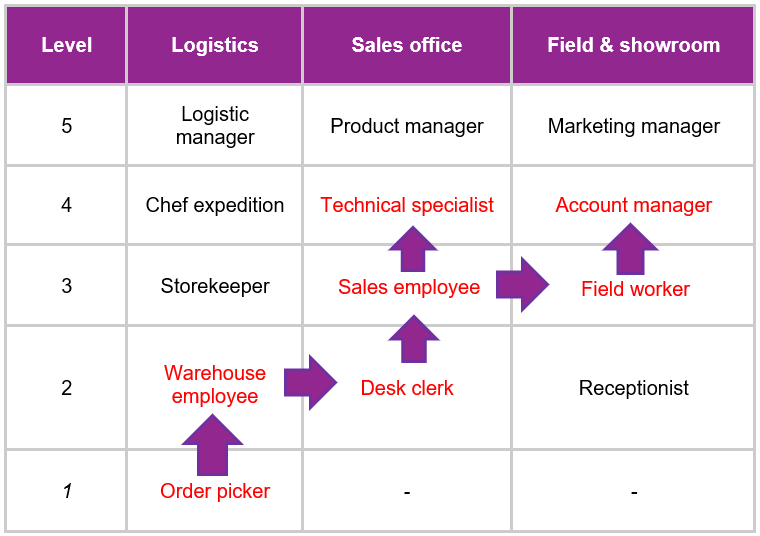Indicator 5 of EQAVET is the placement rate in VET programmes. It is about the destination and employment of VET graduates: the quantitative match of VET supply and labour demand, in particular:
- The proportion of VET programme completers who are placed either in the labour market, further education or training (including university) or other destination within 12-36 months after the end of programme;
- The percentage of VET programme completers who are employed one year after the end of training.
Timely, valid, reliable and comparable statistics are crucial to inform policy formulation, implementation and evaluation, labour market research and goal setting and monitoring.
Therefore, it is useful to collect and visualize both labour and VET data on the sector map, using a similar set up to present the numbers and percentages of labour and VET concerned.
Such labour and VET statistics can derive from different types of sources, including:
- Consultations through direct contacts with sectors representatives
- Consultation of existing online databases
- Population censuses
- Household surveys
- Establishment surveys
The quality and meaning of the statistics produced depends on the characteristics, strengths and limitations of the source(s) used.
STATISTICS ON THE LABOUR MARKET
Labour statistics, as a body of official statistics, encompass a wide range of topics and are linked to work, productive activities, workers, characteristics of the labour market and its operating ways. They are extremely useful to understand labour markets, in particular to identify labour market issues and deficiencies, informing policy formulation, enabling policy evaluation and allowing for macroeconomic monitoring. At the same time, the labour market perspective is among the most important criteria in career choice, being placed in fact in 3rd place (after interest and talent).
OPERATIONAL INSTRUCTIONS
STEP 1 Search for and collect quantitative data at National/Regional level. At this level it could be difficult obtaining precise data.
In the table below the type of data needed are indicated. The more correct the numbers, the easier it is to outline figures such as possible shortfalls and surpluses, for instance.
For each “Occupation” level, data to collect refer to:
- Number of workers
- Percentage of certified employees: workers who obtained the diploma for the relevant VET programme (if the percentage is low, it might be interesting to find out what the concurring recruitment channels are)
- Number of work placements, to understand if they are sufficient
- Number of vacancies
- Percentage of vacancies that are hard to fill: vacancies open for longer than 6 months
| EQF lev. |
Occupation |
#
Workers |
%
Certified |
#
Work
placements |
#
Vacancies |
Hard
to fulfil |
| - |
|
? |
? % |
? % |
? |
% |
| - |
|
? |
? % |
? % |
? |
% |
| - |
|
? |
? % |
? % |
? |
% |
Example 1 Electricians in Sweden
| EQF |
Occupation |
#
Workers |
%
Certified |
#
Work
placements |
#
Vacancies |
Hard
to fulfil* |
| 4 |
Leading/Senior Electrician |
5.000 |
? % |
? % |
450 |
80% |
| 3 |
Electrician |
20.000 |
? % |
? % |
1.500 |
60% |
| 2 |
Assistant Electrician |
20.000 |
? % |
? % |
1.432 |
60% |
Concrete examples from the QSE-VET project are provided below, with reference to the Italian Finance and Banking Sector:
Example 2 Italian Finance and Banking staff
The numbers of employees in the jobs concerned are given in the next table.
| EQF |
Occupation |
#
Workers |
%
Certified |
#
Work
placements |
#
Vacancies |
Hard
to fulfil* |
| 5 |
Area Branch Coordinator |
997 |
100 % |
? % |
0 |
0% |
| 4 |
Branch Manager |
24.932 |
100 % |
? % |
0 |
0% |
| 3 |
Vice Branch Manger |
17.452 |
100 % |
? % |
0 |
0% |
STATISTICS ON IVET
Statistical data over time show trends and provide qualitative and quantitative information for European policy making and analysis and monitoring of Vocational Education and Training (VET).
OPERATIONAL INSTRUCTIONS
At this point training programmes have been classified and compared to the job profiles (I. B)
STEP 1 Search for and collect quantitative data regarding the matching iVET programmes for the job concerned.
For each iVET programme data required are:
- Duration (year/s) of those iVET Program
- Number of students enrolled
- School leavers and graduates per year
- Flow through: percentage of students not entering the labour market, having decided to continue their learning
To be able to compare numbers on labour with those on iVET, it is advisable to present them in a similar way to the data collected for labour market purposes.
The following table shows the type of data required:
| EQF lev |
iVET programs |
Duration |
#
Students |
#
Graduates |
Flow
through |
| - |
|
|
|
|
% |
| - |
|
|
|
|
% |
| - |
|
|
|
|
% |
Collected data provide information regarding:
- the matching iVET programmes for the jobs concerned
- the duration of those programmes
- how many students, school leavers/graduates per year
- how many students will (not) be available for labour (because they are continuing their learning at a higher level)
See section “III. How to establish the (mis)match in QUANTITY
Here (below) there are examples of tables filled in with statistical data provided by Partners of the QSE-VET project in the different areas of investigation chosen.
Example 1 Dutch VET for electrical engineering
| EQF |
iVET programs |
Duration |
#
Students |
#
Graduates |
Flow
through* |
| 4 |
Technician electrical installations (housing and utility) |
3-4 yr |
380 |
90 |
5% |
| 3 |
1st mechanic electrical installations (housing and utility) |
2-3 yr |
1.600 |
507 |
20% |
| 2 |
Mechanic electrical installations |
2 yr |
2.880 |
870 |
60% |
* these students move on to further education and not (yet) in work
Example 2 Italian Finance and Banking Sector
| EQF |
iVET programs |
Duration |
#
Students |
#
Graduates |
Flow
through |
| 4 |
Technical Commercial Institute – Legal Business address |
5 yr |
342.647 total (for 3 addresses: tourism, social activities and commercial) |
|
% |
| 4 |
Management, Finance and Marketing Technical Institute |
5 yr |
|
|
% |
| EQF |
VET programmes (internal mandatory training) |
Duration |
#
Students |
#
Graduates |
Flow
through |
| 4+ |
MIFID |
30 hours min. |
|
/ |
|
| 4 |
IVASS |
30 hours min. |
|
/ |
|
Example 3 The UK kitchen staff
| EQF |
iVET programmes |
Duration |
#
Students |
#
Graduates |
Flow
through* |
| 2 |
Kitchen Assistant: Level 1 Award in Introduction to Employment in the Hospitality Industry; Certificate in General Cookery; Level 2 in food Safety; NVQ Level 2 in Food Preparation and Cooking and Food Service |
Guided Learning Hours range from 69 for introductory courses through to 170 for Food Preparation and Cooking for example |
? |
? |
? |
| 3 |
Cook/Chef de Partie: Foundation Degree in Culinary Arts, Professional Cookery; Higher National Diploma |
12 weeks-2 years* |
? |
? |
? |
| 4/5 |
Head Chef: University Degree in Culinary Arts, Hospitality Management, Professional Cookery; Higher Level Apprenticeship; Higher Level National Diploma |
3-4 years+ if specialist areas are chosen |
? |
? |
? |
More examples:
The Dutch fashion-making industry

The Dutch building merchants’ core staff mobility
The total replacement demand is on average just over 12% per year.
The in- and through flow (in the core functions) determine the targets for the sectors’ most relevant training programmes.

The annual innovations in the field and (average) performance of the people determine the need for further training on professional knowledge and development of professional skills and personal effectiveness.
The technical advisors of the manufacturers are therefore involved in a biennial review / update of the teaching materials of the various training programmes.
The Greek statistics on VET and labour
| Type of enterprises in sector in Greece |
Number of enterprises |
Number of employees |
| Restaurants and mobile units |
41.171 |
209.182 |
| Catering services |
3.435 |
11.428 |
| Fast food services & Cafe |
81.593 |
379.041 |
| Total |
126.199 |
599.651 |
| Type of enterprises in sector in Greece |
Number of enterprises |
Number of employees |
| Restaurants and mobile units |
41.171 |
209.182 |
| Catering services |
3.435 |
11.428 |
| Total |
44.606 |
220.610 |
| EQF |
Occupation |
#
Workers |
%
Certified |
#
Work
placements* |
#
Vacancies* |
Hard
to fulfil** |
| 4 |
Head chef |
9.854 |
86% |
N/A |
N/A |
80% |
| 3 |
Cook/chef de partie |
47.359 |
64% |
N/A |
N/A |
60% |
| 2 |
Kitchen porter/assistant |
163.397 |
11% |
N/A |
N/A |
30% |
| *There is not any available data per occupational profile. The statistical interpretation of the data related to work placement and vacancies are provided in total. **DIMITRA’s approach based on iVET data |
| iVET programme |
Number of graduated students (2017-2018) |
Number of students participated in the certification exams |
Number of certified students |
Percentage |
| Food/cook art |
Approx. 18.000 |
11.352 |
8.548 |
% of graduated: 47.49% % of participated in the exams: 75.29% |
The UK statistics on VET and Labour
| EQF |
Occupation |
#
Workers |
iVET programs |
Duration |
| 4/5 |
Head Chef |
255.000 |
University Degree in Culinary Arts, Hospitality Management, Professional Cookery*; Higher Level Apprenticeship; Higher Level National Diploma |
3-4 years+ if specialist areas are chosen |
| 3 |
Cook |
190.000 |
Foundation Degree in Culinary Arts, Professional Cookery; Higher National Diploma |
12 weeks-2 years* |
| 2 |
Kitchen Assistant |
234.000 |
Level 1 Award in Introduction to Employment in the Hospitality Industry;
Certificate in General Cookery;
Level 2 in food safety;
NVQ Level 2 in Food Preparation and Cooking and Food Service |
Guided Learning Hours range from 69 for introductory courses through to 170 for Food Preparation and Cooking for example |
* Professional Cookery: Level 1 Diploma: 12-weeks; -weeks; Professional Chef – Level 3 Diploma: 1-year
- The Hospitality Sector has the lowest proportion of full-time employees out of all sectors and
- Employs a particularly young workforce (33% <25 years old); 10% are employed on a temporary basis
- The majority of establishments in the sector (approx. 91%) employ fewer than 25 people.
- The sector is relatively low-skilled; only a fifth of the workforce is qualified to level 4 and above, though this varies by sub-sector
- In terms of recruitment issues, 32.700 establishments (15% of all sector establishments) have vacancies; 5% report hard to fill vacancies, with 3% reporting skills shortage vacancies
- A total of 73.700 vacancies were reported across the sector; a quarter of these (18.243) are hard-to-fill and a further 15% (11.178) are skills shortage vacancies
- 61% of hospitality employers provide training
- Restaurants are slightly less likely to provide training (50%)
- 85% of employees receive health and safety/first aid training
- 63% of employees receive induction training
- By far, the reason employers to not provide training is that they say that staff are fully proficient (62%).
Given the vacancies reported, there are plenty of opportunities for students to find work.










